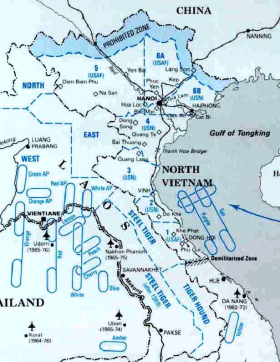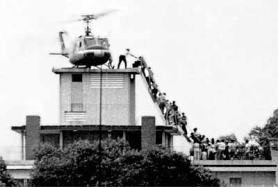The Jet Age:
Air War in Vietnam
By Stephen Sherman, Oct. 2002. Updated March 22, 2012.
As the United States sought to shore up the government of South Vietnam against its Communist foes in the early 1960's, its first moves were slightly indirect: advisors, Special Forces, and local air support. After the widely-publicized Tonkin Gulf Incident in August, 1964, President Johnson stepped up the American effort. Navy strike aircraft hit targets in North Vietnam, American ground forces landed in March, 1965, and almost without realizing it, the United States military was committed to the War in Vietnam, another land war in Asia. For eight years, United States airplanes bombed North Vietnam, fought aerial battles with North Vietnamese MiGs, and dodged flak.
In Country: Air Support, Rescue, and FAC's
In the war in the South against the Viet Cong, U.S. "mud movers" provided direct support to the grunts. It was dangerous, unglamorous work, flying on the deck in the face of intense small arms and anti-aircraft fire. The toughest assignments were those handed to the Forward Air Controllers (FAC's); the flew light airplanes like the Cessna O-1 Bird Dog at treetop level, pinpointing enemy troops with smoke rockets and then hanging around to direct the air strikes. The attack aircraft included the North American F-100 Super Sabre and the prop-driven Douglas A-1H Skyraiders. The old fighter bombers were well-suited to supporting the Huey choppers in rescue missions.
Rolling Thunder: 1965-68
Starting on March 2, 1965, for three years the Americans bombed the North in a tightly controlled, complex, and ultimately ineffective campaign called Rolling Thunder. Republic F-105 Thunderchiefs, or "Thuds" and McDonnell Douglas F-4 Phantoms carried the bombs, dodged the SAM's and engaged the MiGs in dogfights. The Thuds were primarily bombers and the Phantoms dogfighters, but both were capable in either role.
Operation Bolo: 2 January 1967
By late 1966, U.S. losses over North Vietnam (to both MiGs and SAMs)
were mounting. Colonel Robin Olds of the
8th TFW worked up a plan to decoy the PAVNAF (People's Army of Vietnam
North Air Force), setting up Phantoms to electronically resemble Thuds
on a bombing mission. It was a historic ambush, one of the great aerial
battles of all time. In one brief encounter, the Americans' Sidewinder
missiles took down between five and eight Vietnamese MiG-21s (depending
on what source you use). But make no mistake, the destruction of
even five jet fighters in a single battle, in modern air warfare, is
huge. What's more, it is undisputed that the MiGs remained
quiescent for some months after Operation Bolo. Read about it at the
link.
Helicopters in Vietnam
The chopper came of age during the war in Southeast Asia. The ubiquitous UH-1 Hueys ferried troops into battle, "Dustoff" medevac helicopters pulled casualties out, and heavily armed "Hogs" blasted the jungles with 70mm rockets, 7.62mm multi-barrel miniguns, and grenade launchers. By 1967, the AH-1 Huey Cobra entered service, and stayed in the U.S. arsenal for 18 years.
And they stayed to end of the war in Vietnam, lifting refugees out of the U.S. embassy in Saigon.
On Yankee Station
From the beginning of U.S. military action in Vietnam, naval air power was part of it. Four or five big carriers operated from a position 200 miles out from Haiphong, "Yankee Station." Vought F-8 Crusaders and Douglas A-1 Skyraiders flew from the older Essex-class carriers, while McDonnell F-4 Phantoms and Douglas A-4 Skyhawks flew off the bigger flattops. Later in the war, Grumman A-6 Intruders replaced the older Douglas attack aircraft.
In the air-to-air conflict, Navy pilots achieved the first victory on June 17, 1965, when VF-21 Phantoms flown by Cdr. Louis Page and Lt. Jack Batson downed a pair of MiG-17s.
Late in the war, Lt. Randy "Duke" Cunningham and his back seater Lt. Willie "Irish" Driscoll, became the first US aces of the war.
Operation Linebacker: 1972
By 1972, American ground troops had largely been withdrawn. U.S. airpower supported the ARVN (Army of Republic of Viet Nam). While peace talks dragged on, Hanoi held onto the POWs and, in April, launched a general assault on the South. For the first time, B-52's bombed the North, Hanoi and Haiphong were targeted, and harbors were mined. These raids in the spring of 1972 were called "Operation Linebacker." By the fall, peace talks seemed promising, and Nixon halted bombing north of the 20th parallel. But talks promptly bogged down, and just after Christmas, the U.S. launched "Linebacker II," again hitting Hanoi itself with B-52 raids. In eleven days, the North Vietnamese were ready to deal. (Not that this should be seen as an American victory. By December 1972, Nixon and Kissinger were ready to settle for a fig leaf and the return of the POW's, or as they called it, "Peace with Honor.") On Jan. 15, 1973, President Nixon ordered a halt to all offensive air operations in North Vietnam.


